Turmeric (Curcuma longa) is a rhizomatous herbaceous perennial plant of the ginger family, Zingiberaceae. It is native in southeast India, and needs temperatures between 20 °C and 30 °C (68 °F and 86 °F) and a considerable amount of annual rainfall to thrive. Plants are gathered annually for their rhizomes, and propagated from some of those rhizomes in the following season.
When not used fresh, the rhizomes are boiled for about 30–45 minutes and then dried in hot ovens, after which they are ground into a deep orange-yellow powder commonly used as a spice in Indian cuisine and even curries, for dyeing, and to impart color to mustard condiments. One active ingredient in it is curcumin. It has a distinctly earthy, slightly bitter, slightly hot peppery flavor and a mustardy smell. Curcumin may treat cancer, Alzheimer's disease, diabetes, allergies, arthritis and other chronic illnesses.
Turmeric feild
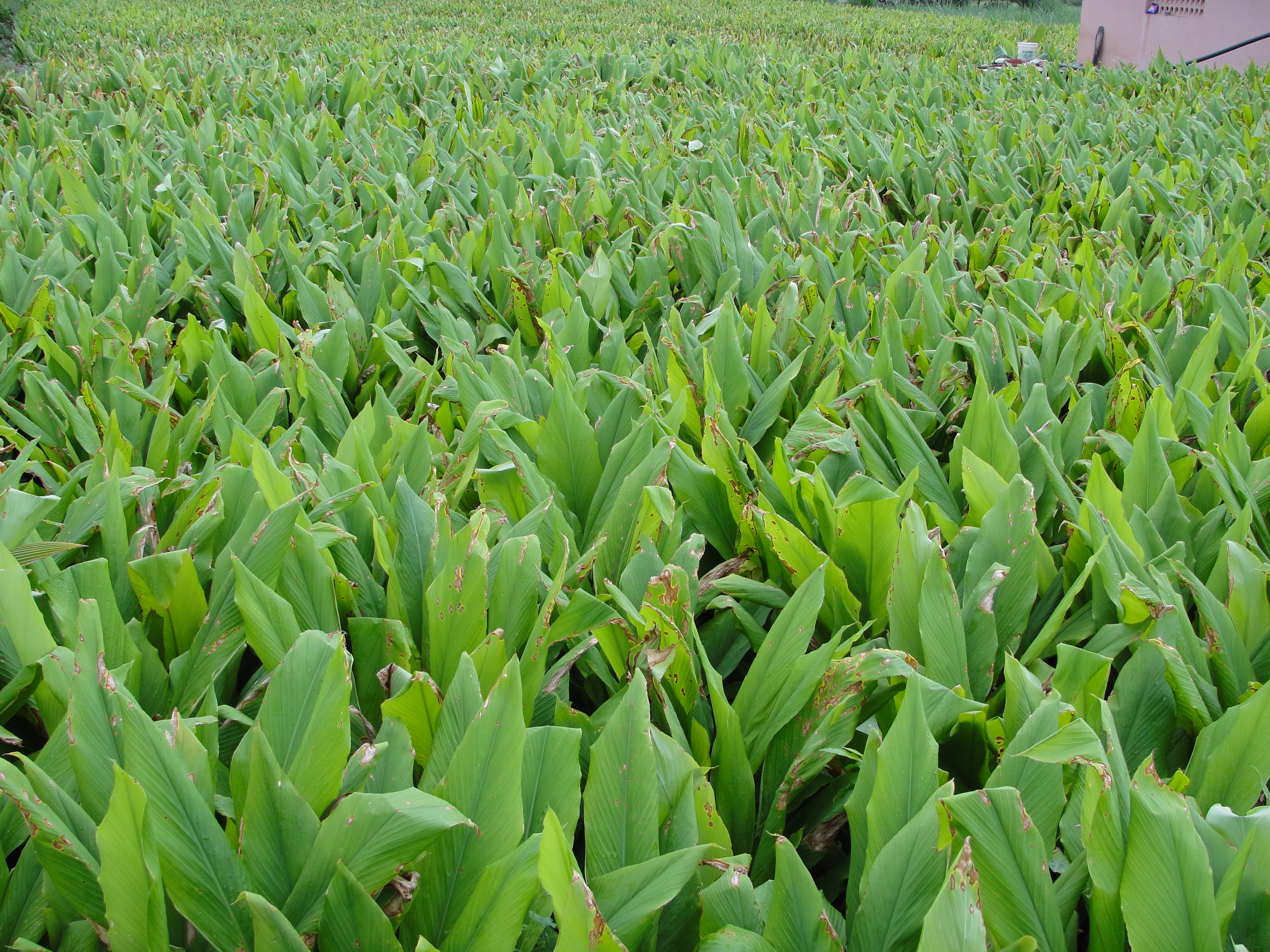 Known as haldi, turmeric has been used in India for thousands of years and is a major part of Siddha medicine. It was first used as a dye and then later for its medicinal properties.
Known as haldi, turmeric has been used in India for thousands of years and is a major part of Siddha medicine. It was first used as a dye and then later for its medicinal properties.

In 1995, a U.S. patent on turmeric was awarded to the University of Mississippi Medical Center, specifically for the “use of turmeric in wound healing.” This patent also granted them the exclusive right to sell and distribute turmeric. Two years later, an Indian government organisation, The Council of Scientific and Industrial Research, filed a complaint on the grounds of piracy. They argued that this usage has been documented and been in practice for thousands of years in India. The patent was subsequently removed as it was proven to be anti-competitive.
In China, the flowering time is usually in August. Terminally on the false stem there is a 12 to 20 cm long inflorescence stem containing many flowers. The bracts are light green and ovate with a length of 3 to 5 centimeters to oblong with a blunt upper end.
At the top of the inflorescence stem bracts are present on which there are no flowers, these are, white to green and sometimes tinged reddish-purple and its upper end is tapered.
 Tillandsia fasciculata, commonly known as the Giant Airplant or cardinal airplant, is a species of bromeliad that is native to Central America, Mexico, the West Indies, northern South America (Venezuela, Colombia, Suriname, French Guiana, northern Brazil), and the southeastern United States (Georgia, Florida).
Tillandsia are epiphytes and need no soil because water and nutrients are absorbed through the leaves. The roots are used as anchors only. Reproduction is by seeds or by offsets called "pups". A single plant could have up to a dozen pups. Tillandsias love bright, indirect sunlight.
Tillandsia fasciculata, commonly known as the Giant Airplant or cardinal airplant, is a species of bromeliad that is native to Central America, Mexico, the West Indies, northern South America (Venezuela, Colombia, Suriname, French Guiana, northern Brazil), and the southeastern United States (Georgia, Florida).
Tillandsia are epiphytes and need no soil because water and nutrients are absorbed through the leaves. The roots are used as anchors only. Reproduction is by seeds or by offsets called "pups". A single plant could have up to a dozen pups. Tillandsias love bright, indirect sunlight.
Indoor arrangement of six Tillandsia plants mounted on a log section.
Although not normally cultivated for their flowers, some Tillandsia will bloom on a regular basis. In addition, it is quite common for some species to take on a different leaf colour (usually changing from green to red) when about to flower. This is an indication that the plant is monocarpic (flowers once before dying) but offsets around the flowering plant will continue to thrive.
Wild Tillandsia fasciculata
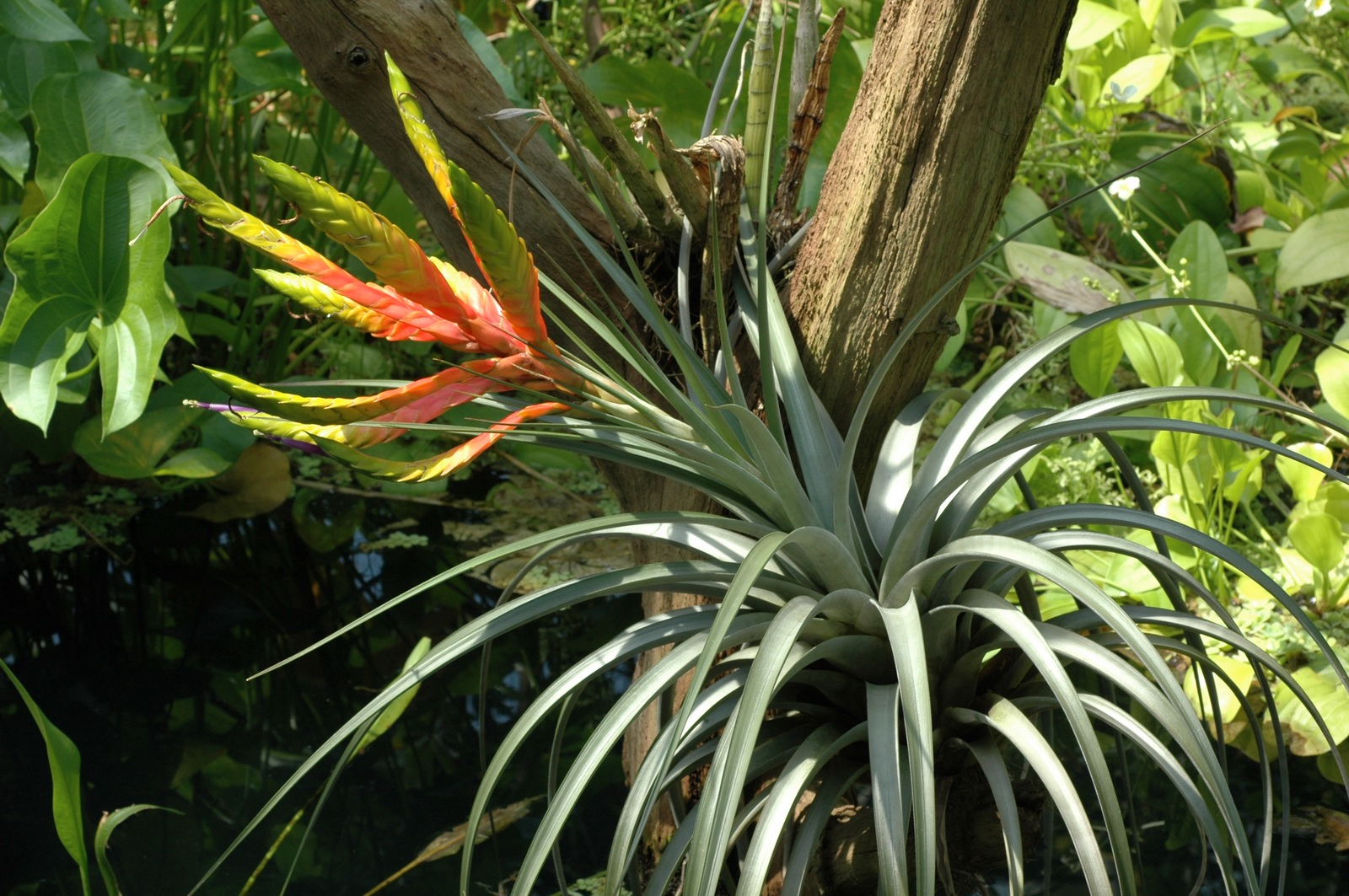

Arum maculatum is a common woodland plant species of the Araceae family. It is widespread across most of Europe as well as Turkey and Caucasus. It is known by an abundance of common names including snakeshead, adder's root, arum, wild arum, arum lily, lords-and-ladies, devils and angels, cows and bulls, cuckoo-pint, Adam and Eve, bobbins, naked boys, starch-root, wake robin, friar's cowl and jack in the pulpit. The name "lords-and-ladies" and other gender related names refer to the plant's likeness to male and female genitalia symbolising copulation.
_-_geograph.org.uk_-_1288449.jpg) Description
The purple spotted leaves of Arum maculatum appear in the spring (April–May) followed by the flowers borne on a poker shaped inflorescence called a spadix. The purple spadix is partially enclosed in a pale green spathe or leaf-like hood. The flowers are hidden from sight, clustered at the base of the spadix with a ring of female flowers at the bottom and a ring of male flowers above them.
Description
The purple spotted leaves of Arum maculatum appear in the spring (April–May) followed by the flowers borne on a poker shaped inflorescence called a spadix. The purple spadix is partially enclosed in a pale green spathe or leaf-like hood. The flowers are hidden from sight, clustered at the base of the spadix with a ring of female flowers at the bottom and a ring of male flowers above them.
Above the male flowers is a ring of hairs forming an insect trap. Insects, especially owl-midges Psychoda phalaenoides, are attracted to the spadix by its faecal odour and a temperature up to 15 degrees celsius warmer than the ambient temperature. The insects are trapped beneath the ring of hairs and are dusted with pollen by the male flowers before escaping and carrying the pollen to the spadices of other plants, where they pollinate the female flowers. The spadix may also be yellow, but purple is the more common.
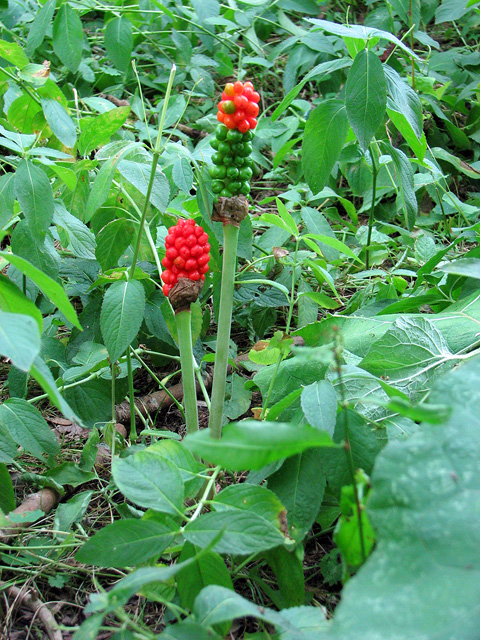
Gentiana cruciata, common name Star Gentian or Cross Gentian, is a herbaceous perennial flowering plant in the Gentianaceae family.
Gentiana cruciata is a hemicryptophyte scapose plant of small size, reaching on average 20–40 centimetres (7.9–15.7 in) in height. It has erect stems, the leaves are large, ovate-lanceolate, semiamplexicaul, about 3–8 centimetres (1.2–3.1 in) long. The flowers are violet-blue trumpets with 4 petals, clustered in the axils of upper leaves. The flowering period extends from June to August. The flowers are hermaphrodite and pollinated by insects (entomogamy). The fruit is a capsule. The seeds are dispersed by gravity alone (barochory).
Gentiana cruciata is widespread in most of Europe (except Portugal, Great Britain and Scandinavia) and in Western Asia.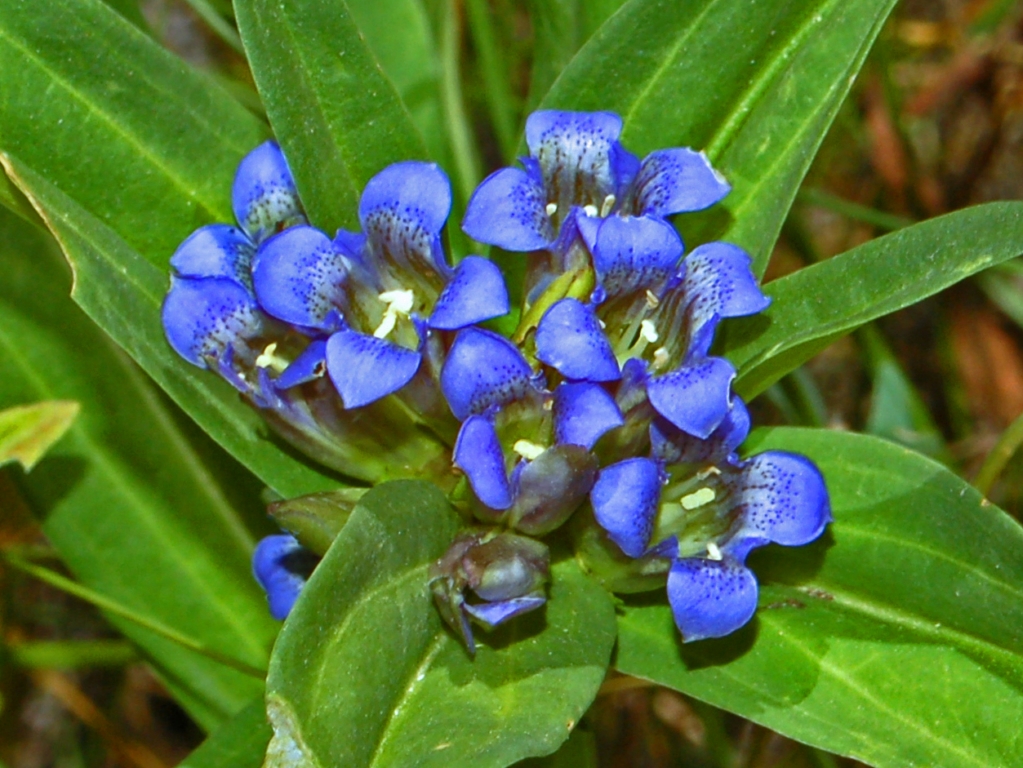
Ipomoea carnea, the pink morning glory, is a species of morning glory. This flowering plant has heart-shaped leaves that are a rich green and 6–9 inches long. It can be easily grown from seeds which are toxic and it can be hazardous to cattle; the toxicity is related to the bioaccumulation of selenium species in leaves but mostly in seeds.
 The stem of I. carnea can be used for making paper. The plant is also of medicinal value. It contains a component identical to marsilin, a sedative and anticonvulsant. A glycosidic saponin has also been purified from I. carnea with anticarcinogenic and oxytoxic properties.
The stem of I. carnea can be used for making paper. The plant is also of medicinal value. It contains a component identical to marsilin, a sedative and anticonvulsant. A glycosidic saponin has also been purified from I. carnea with anticarcinogenic and oxytoxic properties.
Another common name is "bush morning glory", but particularly in temperate North America, that usually refers to I. leptophylla.
In Brazil, I. carnea is known as canudo-de-pita, literally "pipe-cane", as its hollow stems were used to make tubes for tobacco pipes. It thus became the namesake of Canudos, a religious community in the sertão of Bahia, over which the War of Canudos was fought 1893–1897.
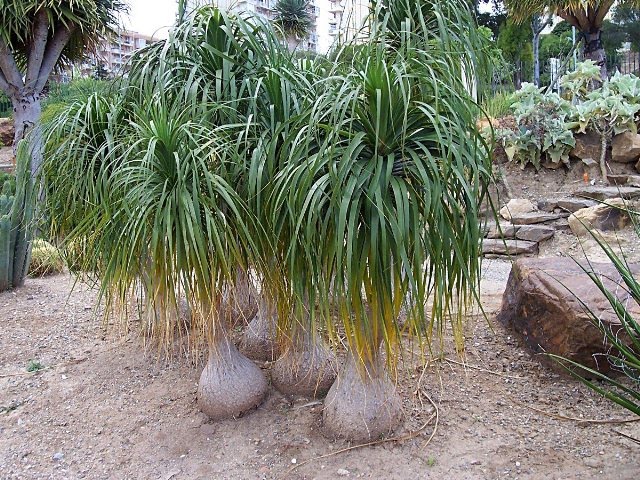 Beaucarnea recurvata (elephant's foot, ponytail palm) is a species of plant in the family Asparagaceae, native to the states of Tamaulipas, Veracruz and San Luis Potosí in eastern Mexico. Despite its common name, it is not closely related to the true palms (Arecaceae). It was discovered in Mexico by a Frenchman in 1870, becoming popular in Europe and worldwide as an ornamental plant. There are 350 year-old Beaucarneas registered in Mexico.
It is an evergreen perennial growing to 15 feet 6 inches (4.72 m) with a noticeable expanded caudex, for the purpose of storing water inside. The single palm-like stem produces terminal tufts of strap-shaped, recurved leathery leaves, sometimes hair lock-shaped in the ends, and with occasional panicles of small white flowers once the plant reaches over 10 years of age.
Beaucarnea recurvata (elephant's foot, ponytail palm) is a species of plant in the family Asparagaceae, native to the states of Tamaulipas, Veracruz and San Luis Potosí in eastern Mexico. Despite its common name, it is not closely related to the true palms (Arecaceae). It was discovered in Mexico by a Frenchman in 1870, becoming popular in Europe and worldwide as an ornamental plant. There are 350 year-old Beaucarneas registered in Mexico.
It is an evergreen perennial growing to 15 feet 6 inches (4.72 m) with a noticeable expanded caudex, for the purpose of storing water inside. The single palm-like stem produces terminal tufts of strap-shaped, recurved leathery leaves, sometimes hair lock-shaped in the ends, and with occasional panicles of small white flowers once the plant reaches over 10 years of age.

There are 10 different species of this plant, according to the Institute of Ecology in Xalapa, state of Veracruz, which runs the Jardín Botánico Francisco Javier Clavijero botanical garden, where over 400 Beaucarneas are exhibited and more are grown in greenhouses for conservation purposes, in the "Colección Nacional de Beaucarneas" (Beaucarneas National Collection).
Growing Conditions:
Light: Bright light. Ponytail palms can be acclimated to full sun.
Water: During the growing season, water every 7 to 14 days. The bulbous stems store water, so be careful not to overwater. During the winter season, cut back water to monthly.
Temperature: They prefer warm, arid temperatures, above 60ºF. However, they will survive down to 50º, providing they are not exposed to prolonged cold.
Soil: Rich, organic, fast-draining potting soil.
Fertilizer: Feed weekly with liquid fertilizer during the growing season, or use a slow-release pellet fertilizer in the spring. Reduce feeding during the winter.
 B. recurvata is often grown as a houseplant or outdoor plant in temperate climate gardens. It is hardy to −5 °C (23 °F), and grows in full sun to light shade. It needs a proper soil mix to drain when watered, and must never be over-watered or mudded, as this will foster pests like the mealybug and cochineal insect. It cannot resist cold temperatures so it must be an indoor plant in countries with strong winters. When repotted it must keep all its roots. To maintain its original shape, the ends of its leaves should not be snipped. It is very slow-growing and drought-tolerant. It has gained the Royal Horticultural Society's Award of Garden Merit.
B. recurvata is often grown as a houseplant or outdoor plant in temperate climate gardens. It is hardy to −5 °C (23 °F), and grows in full sun to light shade. It needs a proper soil mix to drain when watered, and must never be over-watered or mudded, as this will foster pests like the mealybug and cochineal insect. It cannot resist cold temperatures so it must be an indoor plant in countries with strong winters. When repotted it must keep all its roots. To maintain its original shape, the ends of its leaves should not be snipped. It is very slow-growing and drought-tolerant. It has gained the Royal Horticultural Society's Award of Garden Merit.
 Roystonea regia, commonly known as the Cuban royal palm, Florida royal palm, or simply the royal palm is a species of palm which is native to southern Florida, Mexico and parts of Central America and the Caribbean. It ranged into central Florida in the eighteenth century but in modern times it is only known from tropical parts of south Florida. A large and attractive palm, it has been planted throughout the tropics and subtropics as an ornamental tree.
Although it is sometimes called R. elata, the conserved name R. regia is now the correct name for the species. Populations in Cuba and Florida were long seen as separate species, but are now considered to belong to a single species.
Best known as an ornamental, R. regia is also used as a source of thatch, construction timber, and as a medicinal plant. The fruit is eaten by birds and bats (which disperse the seeds) and fed to livestock. Its flowers are visited by birds and bats, and it serves as a roosting site and food source for a variety of animals. Roystonea regia is the national tree of Cuba, and has a religious role both in Santería and Christianity, where it is used in Palm Sunday observances.
Roystonea regia, commonly known as the Cuban royal palm, Florida royal palm, or simply the royal palm is a species of palm which is native to southern Florida, Mexico and parts of Central America and the Caribbean. It ranged into central Florida in the eighteenth century but in modern times it is only known from tropical parts of south Florida. A large and attractive palm, it has been planted throughout the tropics and subtropics as an ornamental tree.
Although it is sometimes called R. elata, the conserved name R. regia is now the correct name for the species. Populations in Cuba and Florida were long seen as separate species, but are now considered to belong to a single species.
Best known as an ornamental, R. regia is also used as a source of thatch, construction timber, and as a medicinal plant. The fruit is eaten by birds and bats (which disperse the seeds) and fed to livestock. Its flowers are visited by birds and bats, and it serves as a roosting site and food source for a variety of animals. Roystonea regia is the national tree of Cuba, and has a religious role both in Santería and Christianity, where it is used in Palm Sunday observances.
 Roystonea regia is a large palm which reaches a height of 20–30 metres (66–98 ft) tall, (with heights up to 34.5 m (113 ft) reported) and a stem diameter of about 47 centimetres (19 in). (K. F. Connor reports a maximum stem diameter of 61 cm (24 in).)
The trunk is stout, very smooth and grey-white in colour with a characteristic bulge below a distinctive green crownshaft. Trees have about 15 leaves which can be up to 4 m (13 ft) long. The flowers are white with pinkish anthers. The fruit are spheroid to ellipsoid in shape, 8.9–15 millimetres (0.35–0.59 in) long and 7–10.9 mm (0.28–0.43 in) wide. They are green when immature, turning red and eventually purplish-black as they mature.
Root nodules containing Rhizobium bacteria have been found on R. regia trees in India. The presence of rhizobia-containing root nodules is usually associated with nitrogen fixation in legumes; this was the first record of root nodules in a monocotyledonous tree.
Roystonea regia is a large palm which reaches a height of 20–30 metres (66–98 ft) tall, (with heights up to 34.5 m (113 ft) reported) and a stem diameter of about 47 centimetres (19 in). (K. F. Connor reports a maximum stem diameter of 61 cm (24 in).)
The trunk is stout, very smooth and grey-white in colour with a characteristic bulge below a distinctive green crownshaft. Trees have about 15 leaves which can be up to 4 m (13 ft) long. The flowers are white with pinkish anthers. The fruit are spheroid to ellipsoid in shape, 8.9–15 millimetres (0.35–0.59 in) long and 7–10.9 mm (0.28–0.43 in) wide. They are green when immature, turning red and eventually purplish-black as they mature.
Root nodules containing Rhizobium bacteria have been found on R. regia trees in India. The presence of rhizobia-containing root nodules is usually associated with nitrogen fixation in legumes; this was the first record of root nodules in a monocotyledonous tree.
Further evidence of nitrogen fixation was provided by the presence of nitrogenase (an enzyme used in nitrogen fixation) and leghaemoglobin, a compound which allows nitrogenase to function by reducing the oxygen concentration in the root nodule. In addition to evidence of nitrogen fixation, the nodules were also found to be producing indole acetic acid, an important plant hormone.
Allium crenulatum, commonly know as the Olympic onion, is a species of plant native to Oregon, Washington, and British Columbia. It grows in the Cascades, the Coast Ranges, the Olympic Mountains, the Wenatchee Mountains, and the mountains on Vancouver Island. There is one report from Alabama, but this needs verification. The species grows on talus slopes and in alpine tundra at elevations of 600–2500 m.
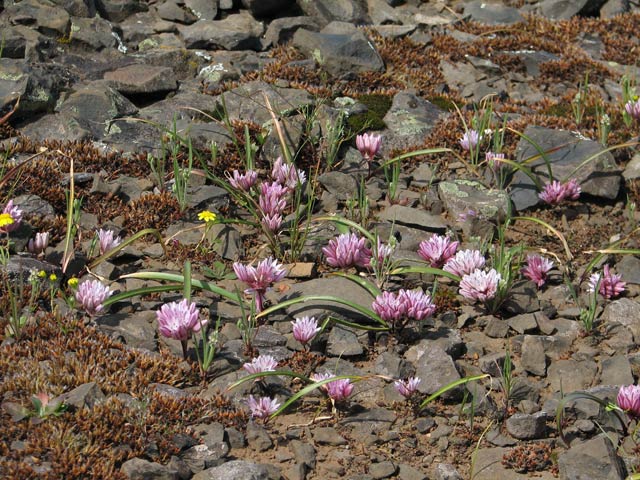 Allium crenulatum produces ovoid bulbs up to 2 cm long, formed on rhizomes some distance from the parent bulb. Leaves are flat, up to 35 cm long, sometimes with minute teeth along the margins. Scape is flattened and winged, up to 15 cm tall. Umbel is compact, with up to 25 flowers. Flowers bell-shaped, up to 13 mm across; tepals pink with darker pink midveins; anthers yellow or purple; pollen yellow.
Allium crenulatum produces ovoid bulbs up to 2 cm long, formed on rhizomes some distance from the parent bulb. Leaves are flat, up to 35 cm long, sometimes with minute teeth along the margins. Scape is flattened and winged, up to 15 cm tall. Umbel is compact, with up to 25 flowers. Flowers bell-shaped, up to 13 mm across; tepals pink with darker pink midveins; anthers yellow or purple; pollen yellow.

Alcea rosea (common hollyhock; syn. Althaea chinensis Wall., Althaea ficifolia Cav., Althaea rosea Cav.) is an ornamental plant in the Malvaceae family.
It was imported into Europe from southwestern China during, or possibly before, the 15th century.William Turner, a herbalist of the time, gave it the name "holyoke" from which the English name derives.
 Alcea rosea is variously described as a biennial (having a two-year life cycle), as an annual, or as a short-lived perennial.It frequently self-sows, which may create a perception that the plants are perennial. The plant may flower during its first year when sown early. It will grow in a wide range of soils, and can easily reach a height of about 8 feet (2.4 m). The flowers are a range of colours from white to dark red, including pink, yellow and orange. Different colours prefer different soils.
Alcea rosea is variously described as a biennial (having a two-year life cycle), as an annual, or as a short-lived perennial.It frequently self-sows, which may create a perception that the plants are perennial. The plant may flower during its first year when sown early. It will grow in a wide range of soils, and can easily reach a height of about 8 feet (2.4 m). The flowers are a range of colours from white to dark red, including pink, yellow and orange. Different colours prefer different soils.
The darker red variety seems to favour sandy soils, while the lighter colour seems to favour clay soils.The plants are easily grown from seed, and readily self-seed.
However, tender plants, whether young from seed or from old stock, may be wiped out by slugs and snails. The foliage is subject to attack from rust (Puccinia malvacearum), which may be treated with fungicides.Commercial growers have reported that some closely related species (Alcea rugosa and Alcea ficifolia) are resistant to this fungus.
This mix of singles features plants which produce huge (4-5" diameter), outward-facing, single flowers in a wide variety of colors including reds, pinks, whites, and light yellows. The flowers grow on rigid, towering spikes or spires which typically reach a height of 5-8' tall and usually do not require staking. Foliage features large, heart-shaped (3, 5 or 7 lobes), rough lower leaves which become progressively smaller toward the top of the spire. Long bloom period of June to August. Sometimes listed in nursery catalogs under Althaea.
Solanum seaforthianum or Brazilian Nightshade is a flowering evergreen vine of the Solanum family native to tropical South America. As a member of the Solanum genus, it is related to such plants as the tomato and potato. It is characterized by clusters of four to seven leaves and can climb to a height of 20 ft (6 m) given enough room. It blooms in the mid to late summer with clusters of star-shaped purple inflorescence followed by scarlet marble-sized berries. The plant is highly heat resistant, but cannot tolerate frost conditions. The plant contains modest amounts of various tropane alkaloids such as atropine, scopolamine and hyoscyamine and should be considered mildly toxic and inedible.
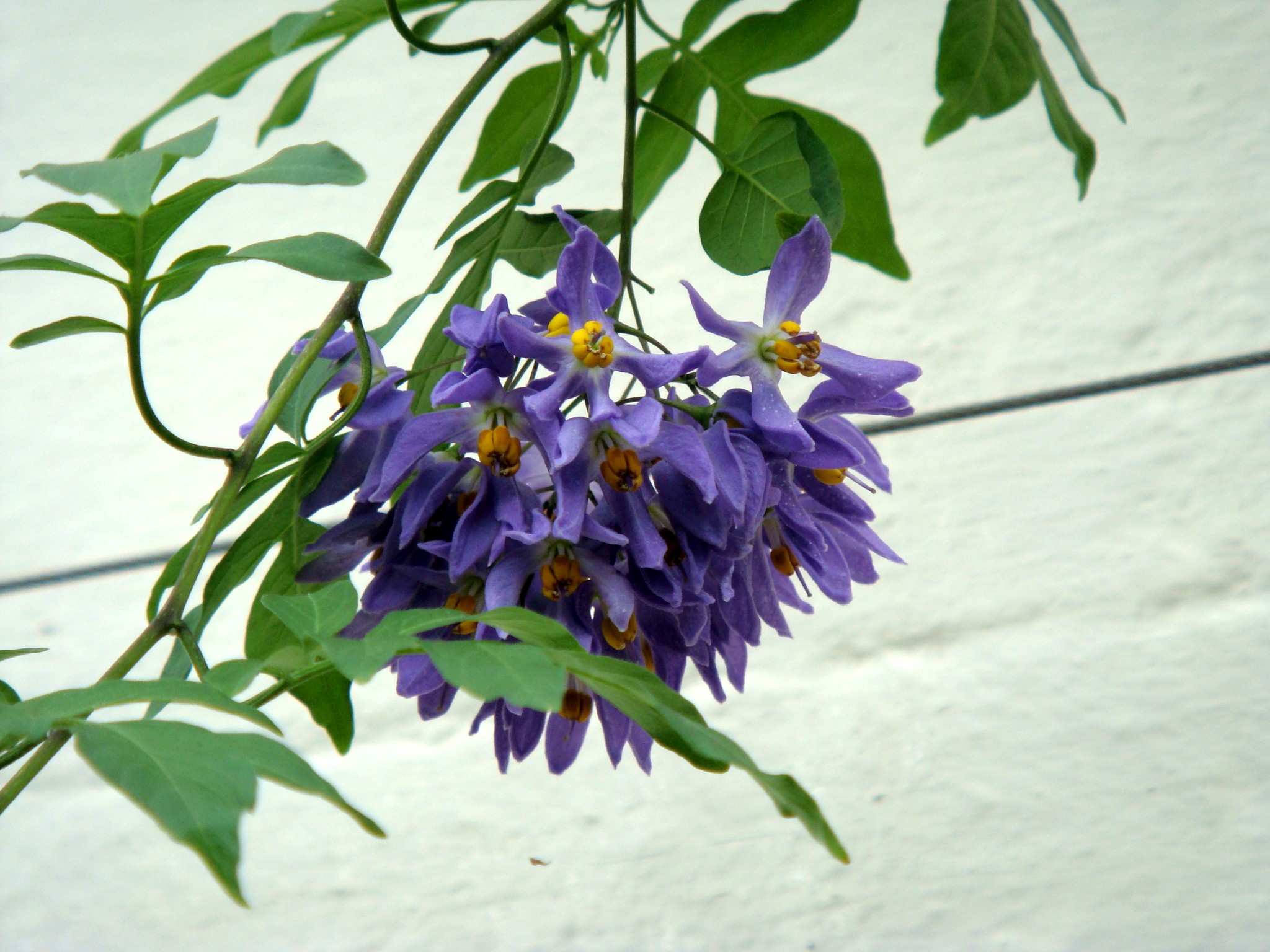 The species has become widely naturalised outside its native range and is an invasive species in Australia, Africa, Indochina, the Pacific Islands and India, choking native vegetation and poisoning livestock.
The species has become widely naturalised outside its native range and is an invasive species in Australia, Africa, Indochina, the Pacific Islands and India, choking native vegetation and poisoning livestock.
Overtops and smothers other species. Poisonous. Indigenous birds could neglect the dispersal of indigenous plants as a consequence of their preference for the fruits of this alien species
 Solanum torvum (Turkey Berry), is a bushy, erect and spiny perennial plant used horticulturally as a rootstock for eggplant. Grafted plants are very vigorous and tolerate diseases affecting the root system, thus allowing the crop to continue for a second year.
The plant is usually 2 or 3 m in height and 2 cm in basal diameter, but may reach 5m in height and 8 cm in basal diameter. The shrub usually has a single stem at ground level, but it may branch on the lower stem. The stem bark is gray and nearly smooth with raised lenticels. The inner bark has a green layer over an ivory color (Little and others 1974). The plants examined by the author, growing on firm soil, had weak taproots and well-developed laterals. The roots are white. Foliage is confined to the growing twigs.
The twigs are gray-green and covered with starshaped hairs. The spines are short and slightly curved and vary from thick throughout the plant, including the leaf midrib, to entirely absent. The leaves are opposite or one per node, broadly ovate with the border entire or deeply lobed. The petioles are 1 to 6 cm long and the blades are 7 to 23 by 5 to 18 cm and covered with short hairs. The flowers are white, tubular with 5 pointed lobes, and grouped in corymbiform cymes. They are shed soon after opening.
The fruits are berries that grow in clusters of tiny green spheres (ca. 1 cm in diameter) that look like green peas. They become yellow when fully ripe. They are thin-fleshed and contain numerous flat, round, brown seeds (Howard 1989, Liogier 1995, Little and others 1974).
Solanum torvum (Turkey Berry), is a bushy, erect and spiny perennial plant used horticulturally as a rootstock for eggplant. Grafted plants are very vigorous and tolerate diseases affecting the root system, thus allowing the crop to continue for a second year.
The plant is usually 2 or 3 m in height and 2 cm in basal diameter, but may reach 5m in height and 8 cm in basal diameter. The shrub usually has a single stem at ground level, but it may branch on the lower stem. The stem bark is gray and nearly smooth with raised lenticels. The inner bark has a green layer over an ivory color (Little and others 1974). The plants examined by the author, growing on firm soil, had weak taproots and well-developed laterals. The roots are white. Foliage is confined to the growing twigs.
The twigs are gray-green and covered with starshaped hairs. The spines are short and slightly curved and vary from thick throughout the plant, including the leaf midrib, to entirely absent. The leaves are opposite or one per node, broadly ovate with the border entire or deeply lobed. The petioles are 1 to 6 cm long and the blades are 7 to 23 by 5 to 18 cm and covered with short hairs. The flowers are white, tubular with 5 pointed lobes, and grouped in corymbiform cymes. They are shed soon after opening.
The fruits are berries that grow in clusters of tiny green spheres (ca. 1 cm in diameter) that look like green peas. They become yellow when fully ripe. They are thin-fleshed and contain numerous flat, round, brown seeds (Howard 1989, Liogier 1995, Little and others 1974).
In Puerto Rico, turkey berry grows in upland sites that receive from about 1000 to 4000 mm of annual precipitation. It also grows in riparian zones in drier areas. Turkey berry grows on all types of moist, fertile soil at elevations from near sea level to almost 1,000 m in Puerto Rico (Little and others 1974) and 2,000 m in Papua New Guinea (Pacific Island Ecosystems at Risk 2001). Given an equal start after disturbance, turkey berry quickly overtops most herbs, grasses, and other shrubs. It grows best in full sunlight and does well in light shade or shade for part of the day, but cannot survive under a closed forest canopy. Turkey berry single plants, groups, and thickets are most frequently seen on roadsides, vacant lots, brushy pastures, recently abandoned farmland, landslides, and river banks.




_-_geograph.org.uk_-_1288449.jpg)










